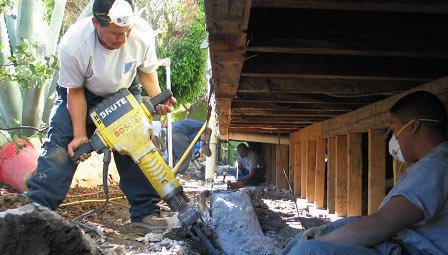by Shawn Kyles
 Replacing a foundation can be a complicated and involved process depending on the size of the structure, its location and the extent of the damage.
Replacing a foundation can be a complicated and involved process depending on the size of the structure, its location and the extent of the damage.
Fully understanding the cause of your foundation problem is the first step in the replacement process. There are many reasons why foundations fail. Bad design, poor soil conditions and moisture issues are some of the more common causes of foundation instability and collapse.
Examples of an improperly designed foundation include inadequate support and reinforcement, cement that hasn’t been cured correctly and a foundation that is too thin. Poor soil conditions typically involve soil that expands when wet and contracts when dry. Plumbing leaks and inadequate drainage can also create havoc with a foundation.
Whether the problem is design, soil or moisture, the result will be foundation settlement. Indicators of settlement include wall cracks and sloping floors, as well as doors and windows that won’t open or close properly
Resolving these underlying issues before replacing your current foundation is critical in order to prevent future foundation deterioration.
Replacing a foundation typically involves replacing both the foundation walls and cement slab. In some cases, the first floor of the structure may need to be removed as well.
When replacing foundation walls, the house will need to be lifted several feet above the foundation. Your utilities will need to be turned off, and your water and sewer lines shut down. A trench will need to be dug around your home and shored in order for the cripple walls to be removed. After the cripple walls have been taken out, your basement slab can be removed.
If the dirt under the slab wasn’t properly compacted, it may need to be excavated and replaced.
New cement walls will need to be poured and given time to cure. Sometimes steel beams or similar types of reinforcement may be necessary to provide additional support for your home. In some situations, more extensive temporary support may be needed during the project, especially with structures that have more than one floor.
Once the new slab has been laid, underground utilities will need to be brought up and reconnected. The excavation around the walls will require filling and proper grading as well.
At this point, the house can be put back on the foundation. Any remaining utilities will need to be reconnected, and the last interior and exterior repairs completed.
Depending on the extent of the work that needs to get done, you may be able to live in your home while the foundation is being replaced. An experienced foundation repair expert can tell you how long the job will take and what to expect at each stage of the project.
Replacing a foundation is a worst-case scenario when it comes to foundation damage. Regular home inspections will often uncover foundation problems before they become serious. Correcting these issues early-on can save you the time and expense of a full foundation replacement. If you have any concerns about your current foundation, contact a knowledgeable foundation contractor and request a free inspection. The sooner you start any necessary repairs, the better.
Replacing home's foundation is a very critical thing to do. You'll not know the safeness of your home after having it.
ReplyDelete